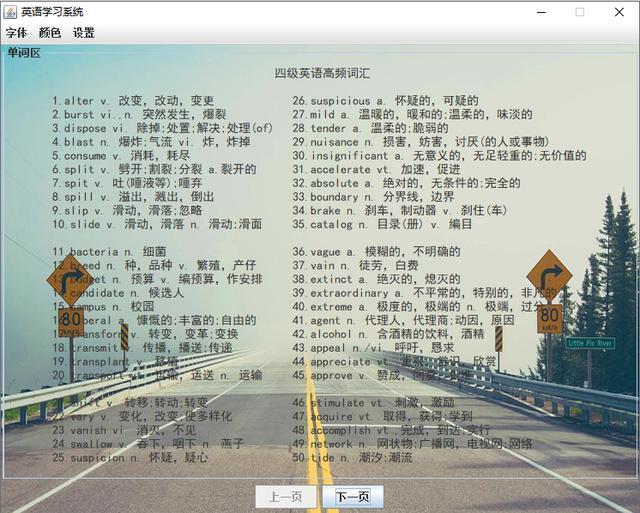使用Java带你打造一款简单的英语学习系统
【一、项目背景】
随着移动互联网的发展,英语学习系统能结构化的组织海量资料。针对用户个性需求,有的放矢地呈现给用户,从而为英语学习者提供便利,提升他们的学习效率。
【二、项目目标】
1. 实现美观的界面,添加需要的组件。
2. 能够基本实现改变字体,颜色,背景,页面切换功能。
3. java读取txt文件,简化代码。
【三、项目实施】
使用eclipse软件开发,先上效果图,如下图所示。可以看到在界面上有可以改变字体、颜色、设置选项的菜单栏,页面切换的功能。

接下来,小编带大家进行具体的实现,具体的实现步骤如下。
【四、实现步骤】
一、首先实现窗体界面
具体的代码实现过程如下:
public static void main(String[] args){
// TODO Auto-generated method stub
EnglishSystem es =new EnglishSystem();
es.setTitle("英语学习系统");
es.setSize(750, 600);
es.setVisible(true);
es.setResizable(false);
es.setLocationRelativeTo(null);
}
使用new关键字创建EnglishSystem类;
setTitle表示设置界面的标题;
setSize(宽,高)表示窗体大小;
setVisible(true或false)表示窗体是否可见;
setResizable(true或false)表示窗体是否可以由用户调整大小;
setLocationRelativeTo()表示设置窗口相对于指定组件的位置。
二、实现菜单栏

1. 创建JFrame实例、JPanel面板,然后把面板添加到JFrame中。
2. 创建JMenuBar菜单栏对象,JMenu在创建菜单对象,将菜单对象添加到菜单栏对象中。
3. 将JMenuItem菜单项添加到JMenu中。
public class EnglishSystem extends JFrame {
private JPanel panel01 = new JPanel();//菜单栏
private JMenuBar jb = new JMenuBar();
private JMenu menu01 = new JMenu("字体");
private JMenuItem item01 = new JMenuItem("宋体");
private JMenuItem item02 = new JMenuItem("黑体");
private JMenu menu02 = new JMenu("颜色");
private JMenuItem item03 = new JMenuItem("玫红色");
private JMenuItem item04 = new JMenuItem("蓝色");
private JMenuItem item05 = new JMenuItem("绿色");
private JMenuItem item06 = new JMenuItem("橘色");
private JMenuItem item07 = new JMenuItem("黑色");
private JMenu menu03 = new JMenu("设置");
private JMenuItem item08 = new JMenuItem("换壁纸");
private JMenuItem item09 = new JMenuItem("退出");
4. 实现单词区
private JPanel panel03 = new JPanel();//单词显示
private static JTextArea text01 = new JTextArea(30,89);
5. 实现上下页切换
private JPanel panel04 = new JPanel();
private JButton btn_next = new JButton("下一页");
private JButton btn_last = new JButton("上一页");
6. 当前背景的图片
private int photoNum=1;//背景图数
private JPanel imagePanel;
private ImageIcon bg= new ImageIcon("photo//photo"+photoNum+".png");//背景图
private JLabel label = new JLabel(bg);
7. EnglishSystem类构造函数:构造这个函数主要是实现界面的设计,添加组件。
EnglishSystem(){
jb.add(menu01);
jb.add(menu02);
jb.add(menu03);
menu01.add(item01);
menu01.add(item02);
menu02.add(item03);
menu02.add(item04);
menu02.add(item05);
menu02.add(item06);
menu02.add(item07);
menu03.add(item08);
menu03.add(item09);
panel01.add(jb);
this.add(panel01);
this.setJMenuBar(jb);
panel03.add(text01);
text01.setText(str1);
text01.setEditable(false);
text01.setLineWrap(true);
text01.setWrapStyleWord(true);
panel03.setBorder(new TitledBorder("单词区"));
this.add(panel03,BorderLayout.CENTER);
text01.setFont(new Font("黑体",Font.PLAIN,14));
8. 将字体、颜色、背景添加到JMenuBar菜单栏中,字体里面的菜单项如黑体、宋体添加到菜单中。其他颜色、背景添加组件也一样!
panel04.add(btn_last);
panel04.add(btn_next);
this.add(panel04,BorderLayout.SOUTH);
text01.setOpaque(false);
panel01.setOpaque(false);
panel03.setOpaque(false);
panel04.setOpaque(false);
label.setBounds(0,0,bg.getIconWidth(),bg.getIconHeight());//设置边界
imagePanel=(JPanel)this.getContentPane();//获取窗体的内容面板
imagePanel.setOpaque(false);//设置透明
this.getLayeredPane().add(label,new Integer(Integer.MIN_VALUE));
9. 定义事件处理类,实现事件监听器
private MyListener my = new MyListener();
10. 在EnglishSystem构造函数中给指定组件添加监听
item01.addActionListener(my);
item02.addActionListener(my);
item03.addActionListener(my);
item04.addActionListener(my);
item05.addActionListener(my);
item06.addActionListener(my);
item07.addActionListener(my);
item08.addActionListener(my);
item09.addActionListener(my);
btn_next.addActionListener(my);
btn_last.addActionListener(my);
11. 添加事件监听器MyListener(自己命名)。
private class MyListener implements ActionListener{
@Override
public void actionPerformed(ActionEvent e) {
// TODO Auto-generated method stub
if(e.getSource()==item01){//宋体
text01.setFont(new Font("宋体",Font.PLAIN,14));
}
if(e.getSource()==item02){//黑体
text01.setFont(new Font("黑体",Font.PLAIN,14));
}
if(e.getSource()==item03){//玫红色
text01.setForeground(new Color(255,0,255));
}
if(e.getSource()==item04){//蓝色
text01.setForeground(Color.blue);
}
if(e.getSource()==item05){//绿色
text01.setForeground(new Color(0,100,0));
}
if(e.getSource()==item06){//橘色
text01.setForeground(new Color(255,140,0));
}
if(e.getSource()==item07){//黑色
text01.setForeground(Color.BLACK);
}
if(e.getSource()==item08){//换壁纸
photoNum++;
if(photoNum>=6){
photoNum=1;
}
label.setIcon(new ImageIcon("photo//photo"+photoNum+".png"));
}
if(e.getSource()==item09){//退出
dispose();
}
if(e.getSource()==btn_next){//下一页
if(papeNum<s.length){//不是最后一页
papeNum++;
btn_last.setEnabled(true);
btn_next.setEnabled(true);
}
if(papeNum==s.length){
btn_last.setEnabled(true);
btn_next.setEnabled(false);
}
}
if(e.getSource()==btn_last){//上一页
if(papeNum>1){//不是第一页
papeNum--;
btn_last.setEnabled(true);
btn_next.setEnabled(true);
}
if(papeNum==1){
btn_last.setEnabled(false);
btn_next.setEnabled(true);
}
}
12. 程序中显示文字是以String数组形式存储,这种方式比较方便易懂,但却使得代码较多。因此,在文字较多情况下,应考虑以txt文档形式存储故事文字,在程序中读取文档内容,以显示在窗口中。
读取Txt文件:
File file = new File(s[papeNum-1]);
String str1 = getFileContent(file);
text01.setText(str1);
13. 定义一个字符串数组
private String[] s = new String[]{"resource//s01.txt","resource//s02.txt","resource//s0 3.txt","resource//s04.txt","resource//s05.txt","resource//s06. txt","resource//s07.txt","resource//s08.txt","resource//s09.tx t","resource//s10.txt","resource//s11.txt","resource//s12.txt", "resource//s13.txt","resource//s14.txt"};
private int papeNum=1;//页数
14. 在getFileContent函数获取文件内容
private String getFileContent(File file) {//获取文件内容
BufferedReader br = null;
StringBuffer sb = new StringBuffer();
try {
br = new BufferedReader(new FileReader(file));
String hasRead = null;
while ((hasRead = br.readLine()) != null) {
sb.append(hasRead + "
");
}
} catch (Exception e) {
} finally {
if (br != null) {
try {
br.close();
} catch (IOException e) {
}
}
}
return sb.toString();
}
以上用到的组件主要是Java Swing图形界面开发:
1. Swing是JAVA的基础类的一部分。
2. Swing包括了图形用户界面(GUI)器件如:文本框,按钮,分隔窗格和表。
3. Swing 提供了许多比 AWT 更好的屏幕显示元素,使用纯 Java 实现,能够更好的兼容跨平台运行。
【五、总结】
1. 主要介绍了JPanel、JButton、JLabel、JTextArea、JMenu、JMenuItem等组件的基本使用,以及相应的事件处理。
2. 事件处理函数的添加,难点是运用理解构造函数、内部类的创建。
3. 如果需要本文源码,请在公众号后台回复“英语系统”四个字获取。
看完本文有收获?请转发分享给更多的人
IT共享之家

想学习更多Python网络爬虫与数据挖掘知识,可前往专业网站:http://pdcfighting.com/


